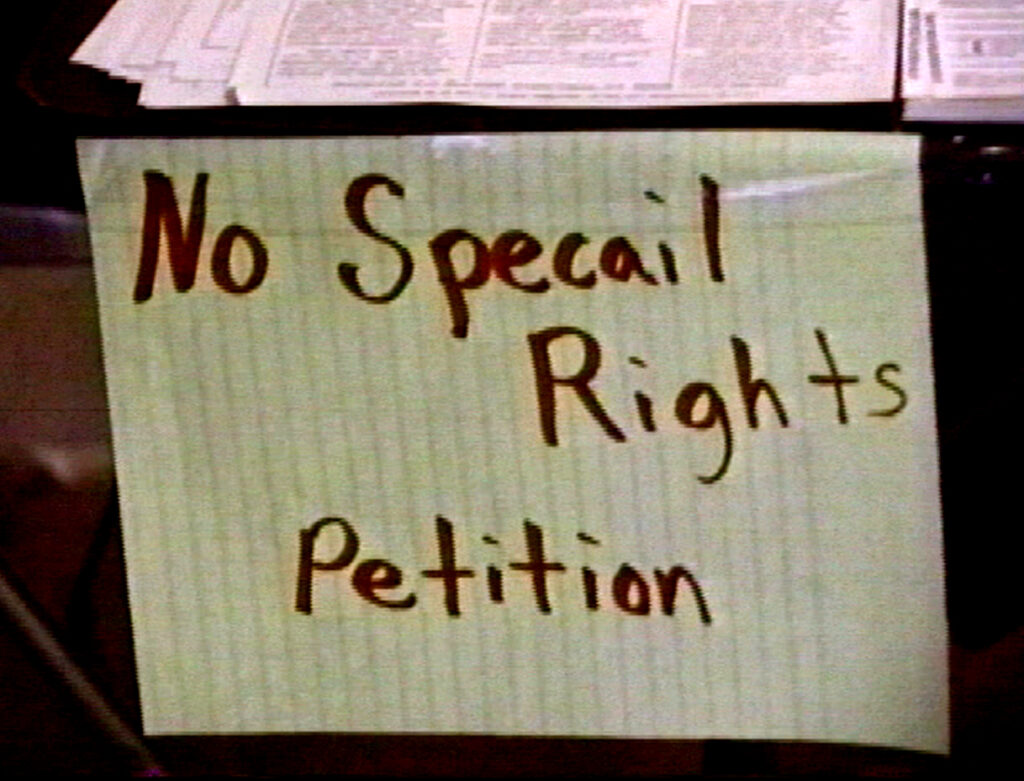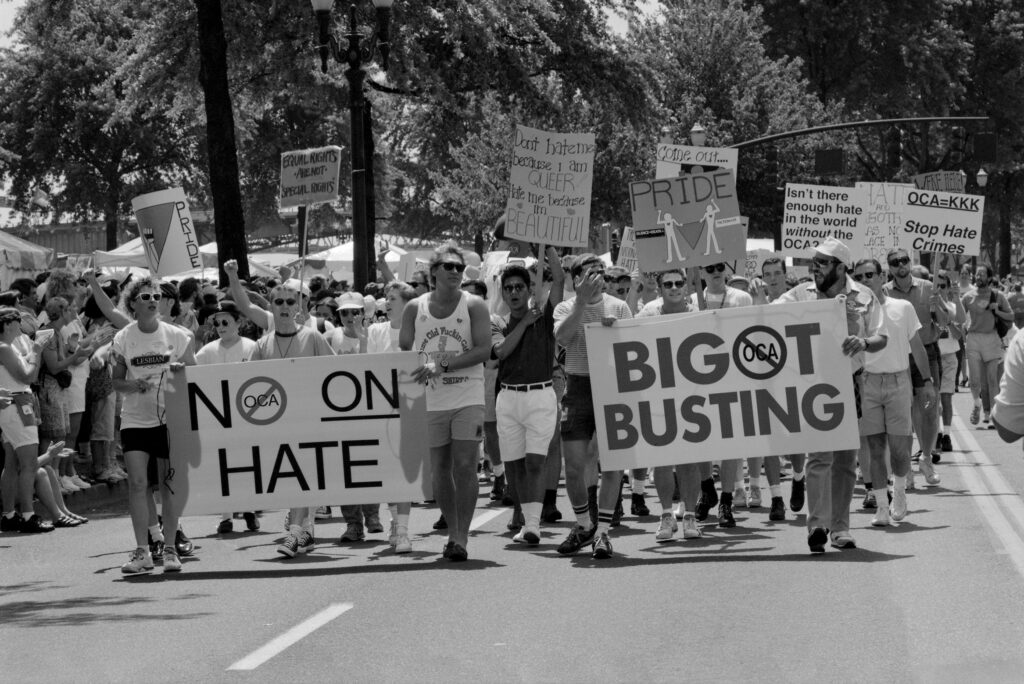“One Sunday my daughter and I were baking,” Anne Sweet remembers. “We didn’t have one of the spices we needed, so we went to the Safeway across the street from our house. And there was the Oregon Citizens Alliance (OCA), right at the entrance. They were strategically targeting Black parishioners, waiting for the moment when church let out when lots of Black people would be going to the store.
“My daughter said, ‘Mom, please don’t make a scene! Let’s just get our spices.’ But people were signing. It was just an awful feeling, to see them giving in to that homophobic piece that’s embedded in Christianity and agreeing that gay and lesbian folk should be gone after in this way.
“So I started asking people not to sign. The store manager told me I had to leave or he’d have me arrested – he didn’t say that to the OCA! That’s when I called Bob, and soon after, the Bigot Busters just came out of the sky. The Safeway parking lot was filled with every kind of gay person of every stereotype and description – they all showed up. It was one of the best moments of the whole campaign for me!”

Bigot Busting 101
“We set up Bigot Busters to suppress signature gathering by the OCA,” remembers Robert Doyle, a gay SEIU member at that time. “It didn’t keep Measure 9 off the ballot but it was clear that directly challenging the lies and misinformation changed minds. We have to be out, loud and proud about our democracy and equality.”
Bob Ralphs, the burly bear of a gay man who founded Bigot Busters, is now deceased and remembered in periodic Facebook posts as “funny as hell,” “very loving,” and “a good friend [who] fought for equality with every fiber of his being while keeping his grand sense of humor and his high-level cooking skills alive to share with us all.” He left a primer on Bigot Busting as part of the NGLTF Fight the Right Action Kit.
“Bigot busting has two primary objectives: preventing petition signatures, and providing a gay-positive experience to as many people as possible. An individual who might have signed a petition earlier can become an ally when confronted with the truth.”
Bob Ralphs, NGLTF Fight the Right Action Kit
As evidence of the method’s effectiveness, Bob could point to the OCA’s failed attempt to put a local version of Measure 9 on the Portland ballot in the same primary election as similar measures were embraced by voters in Springfield and rejected by voters in Corvallis.
“Why did Portland pose such a problem for the Oregon Citizens’ Alliance petitioners?” Bob asked. “Because, in part, wherever they went, the Bigot Busters would follow.”
Bob’s “Action Kit” section explains the dynamics at play: “Our presence and effective presentation of the reality behind the rhetoric of the Christian right can result in the inability of our opponents to gather enough signatures to put their measures to a vote. Especially in urban communities where extreme homophobia is unpopular, potential signers are often too embarrassed to add their names to petitions.
“Very often, the rhetoric used by the religious right to encourage people to sign their petitions succeeds by presenting us as a menace, as evil, unlawful, distasteful people whose special rights agenda must be stopped. By participating in bigot busting, our mere presence deflates many of those arguments. People approaching the petitioners can see some real living, breathing, walking and talking homosexuals calmly explaining the impact of right wing initiatives.”
The Courage to Remain Calm
The national TV news magazine 48 Hours captured the festive scene in the Safeway parking lot after Bob answered Anne’s call. The courage required to engage alongside OCA petitioners was also featured in Fighting for Our Lives, a 20-minute video produced by Elaine Velazquez & Barbara Bernstein as an organizing tool during the campaign.
In a Builders Square parking lot, an OCA petitioner asks someone off camera, “Have you had a chance to sign, sir? No special rights for the homosexuals!” She gestures over her shoulder to a young gay man standing nearby holding a placard who can be heard to say, “Don’t support discrimination. Don’t sign.”
The woman tries again with two young men, one long-haired wearing a hardcore punk band t-shirt, the other bare-chested in a backwards baseball cap.
“Have you had a chance to sign? No special rights for the homosexuals. We don’t want them to be a minority.” Seeing her targets looking at the gay man nearby, she gestures again, “This is the homosexuals. I’m not for them.”
The long-haired guy loudly gathers his saliva and hurls a ball of spit on the gay man. “Fucking faggot! Get the fuck out!”
The gay man responds calmly, “That’s assault.”
“Oh it’s assault?” the assailant says. “Good! Arrest me! Where’s the pigs at? You fucking faggot.” He proceeds to take up a pen and clipboard to sign the petition.
Nearby, another OCA petitioner tries to draw people to the signature gathering table by shouting like a carnival barker, “These are the Bigot Busters right here. Their purpose is to try to intimidate you so you will not sign this petition.”
One passerby responds loudly, “Smear the queer with the baseball bat!”
Non-Violent De-escalation
Given the potential for “violence and messy confrontations” like this, Bob’s Dos and Don’ts included:
- All bigot busters should be trained in non-violent de-escalation tactics.
- No one should go alone.
- Don’t engage in lengthy discussions about the issues, and don’t argue with belligerent petitioners or signers.
- Bigot busters should come back together at a designated time and place to return leftover materials and to debrief. At this point, the coordinator should count heads; those who chose not to attend debriefing sessions should be accounted for.
Bob’s tips also included how to establish a Bigot Busters Dispatch Line, recruit and train volunteers, and coordinate the action in the field – “have one trained, cool-headed Bigot Buster serve as the site coordinator.”
To identify where Bigot Busters would be needed, he advised: “Calling the opponents’ campaign and asking where you might find a petition to sign is a quick and efficient way to track them down.” And apply common sense: “Become familiar with the areas where petitioners frequently gather. Large grocery stores, malls, professional sports events, and large outdoor gatherings are likely petition hot spots.”
Once common spots were identified, teams of volunteers would go to these “preplanned” sites “on evenings or weekends when it is known that petitioners are out.” In addition, teams should be ready for rapid response – “able to gather supplies and people and transport spontaneously to a petitioning site,” like the Safeway across from Anne’s house. Another example: “Someone attending a Portland Trailblazers game saw two OCA petitioners, called the hotline, and three Busters arrived within minutes to counteract the signature gatherers.”
The heart of the Bigot Buster interaction was “to give short, effective answers to the questions that are likely to be asked,” supported by “informational flyers, impact statements, favorable editorials, etc.”
Building Community
Bob was a seemingly tireless community organizer. In addition to founding and serving as lead organizer of Bigot Busters, he was a founder and organizer of the Portland-based No On Hate Political Action Committee, one of the efforts working parallel to the “official” No on 9 campaign. After the campaign he served as the coordinator of the Oregon delegation to the 1993 national March on Washington for Lesbian & Gay Rights and advised activists in Washington state facing a copycat OCA measure.
Through all of this Bob cooked for everyone he organized. He was a big, sometimes controversial personality, who knew how to make things happen. His highly visible leadership made him a target. At one point the brake lines on his car were cut, and he routinely faced threats of violence and death.
At the end of the day, Bigot Busting was as much about community empowerment – being “out, loud and proud about our democracy and equality” – as it was about exposing bigotry and inviting people to make another choice.
Bob held his own organizing to the same standard of inclusion.
“Allow people to talk about good and bad experiences they had during the day,” he advised. “Take suggestions for how things could be done better, and take the time to answer questions that came up during the day. It is important to maintaining unity and enthusiasm that people be given the chance to give feedback.”
Bob died at age 45 of a heart attack in 1995. Twenty-one years later Kathleen Saadat wrote on Facebook: “Those of us who knew him miss his presence and the annual fried chicken dinner at his house. If you don’t know him, let me introduce the original Bigot Buster, Robert Ralphs. While he’s no longer on this plane of life, his words and actions reverberate through time.”
“It feels like we, at this historical moment, might need a reminder of another Pride Hero, BOB RALPHS.”
Kathleen Saadat, in a June 2021 repost of her 2016 Facebook message

As they say on The Moth Radio Hour, “Moth stories are true as remembered and affirmed by the storyteller.” Read more about the benefits and challenges of historical memory.
